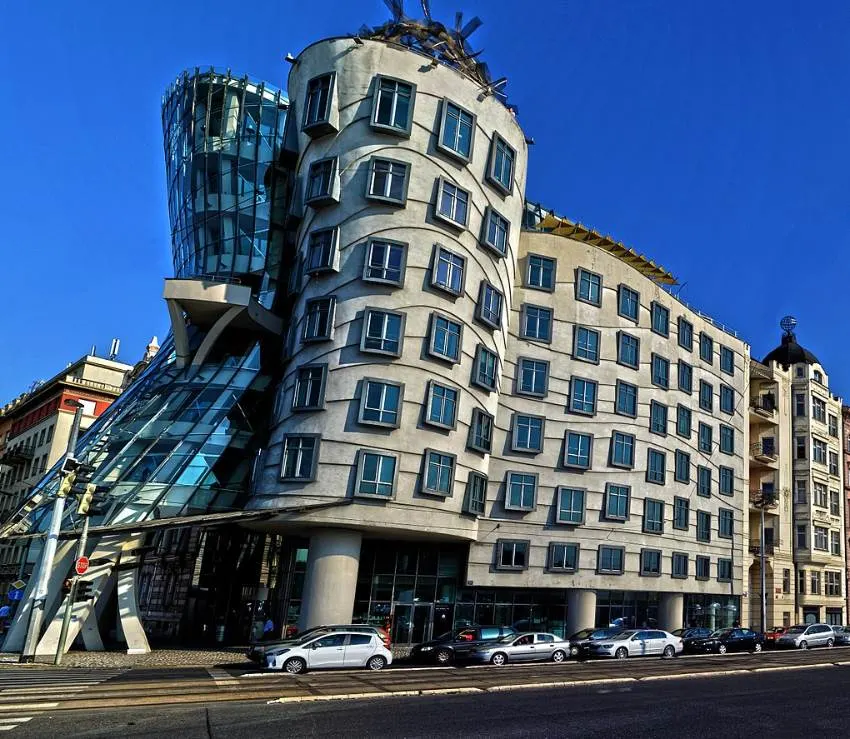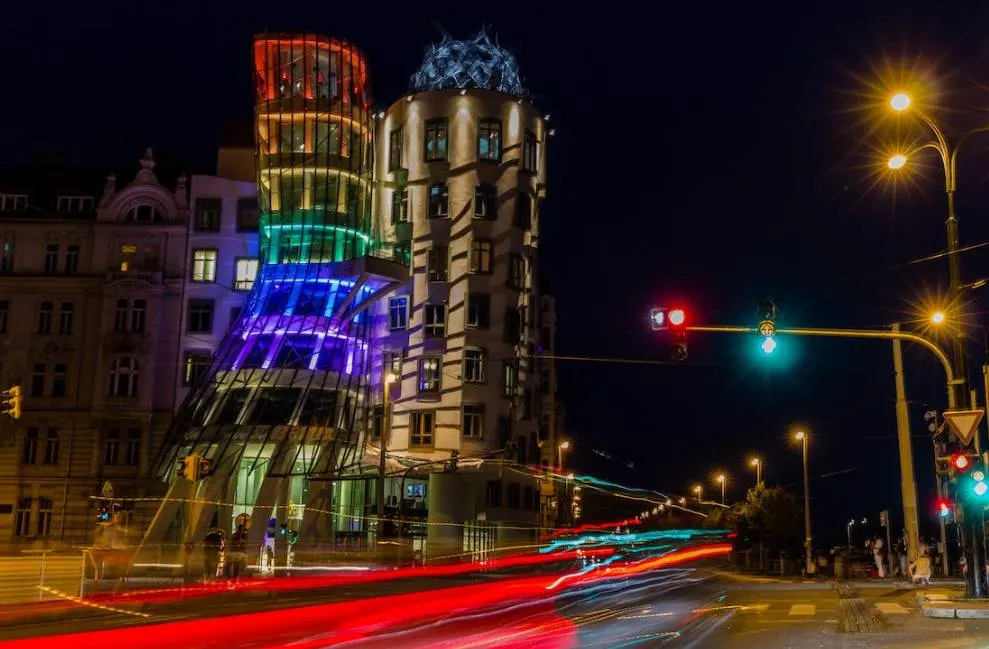It’s not often that you come across a building that appears to be moving, but that’s exactly what this famous landmark in Prague does.
It’s considered to be one of the most prominent examples of Deconstructivist architecture in the world and is nicknamed after a famous dancing couple (although it’s not often used)
Let’s take a closer look at some of the most interesting facts about the Dancing House, arguably one of the most remarkable buildings ever constructed.
1. It’s located just south of Prague’s Old Town on the banks of the Vltava River
The Dancing House is the common name of a building in Prague that is officially known as the “Nationale-Nederlanden building.”
It’s located on the Rašínovo nábřeží or “Rašín Embankment” which means that it’s situated on the banks of the Vltava River which flows through the city.
This is situated in the so-called New Town of Prague, which borders the Old Town, the historical heart of the city, to the south and east.
It’s fair to conclude that this is one of the most peculiar buildings in the capital city of the Czech Republic in Central Europe.

2. The office block was commissioned by a Dutch insurance company
The Nationale-Nederlanden is a Dutch Insurance company that was part of the ING Bank between 1991 and 2016.
The company was doing great in the early 1990s and had a virtually unlimited budget to construct a building in Prague to serve as its local headquarters.

The design of this remarkable structure was finished in 1992 and the building was completed 4 years later in 1996.

3. It was constructed on a plot that was bombed during the 1945 Bombing of Prague
This area in Prague has been densely populated since the 19th century. This means that there were much older buildings standing here before the Dancing House was completed in the 1990s.
The reason why it was possible to build the structure here was that the former buildings, which dated back to the 18th and 19th centuries, were destroyed by the U.S. Bombing of Prague in 1945.
The remains of these shattered buildings were demolished in 1960 and the area lay vacant all this time.
What’s fascinating about this area is that Václav Havel (1936-2011), the final President of Czechoslovakia between 1989 and 1992 and the first president between 1992 and 2003, spent his childhood years in the building next to it.
Havel was a leader of the Velvet Revolution in 1989 which marked the end of the Communist rule in the country.

4. The building was designed by a renowned Canadian-American architect
Another fascinating fact about the Dancing House in Prague is that its architect, Frank Gehry, wasn’t the first choice of the financial institution which commissioned it.
The first invited French architect Jean Nouvel but he rejected the project because it had a limited floor space. Nouvel did, however, design the Golden Angel complex in Prague which was completed in 2001.
Frank Gehry is a Canadian-born American architect who worked together with local architect Vlado Milunić to complete the design of the building.
Gehry designed some of the most famous Deconstructivist buildings in the world, including the Walt Disney Concert Hall in Los Angeles and the Museum of Pop Culture in Seattle, to name just a few of his most famous works.

5. The building’s design has a significant deeper meaning for the Czech Republic
Gehry’s partner on this project was Vlado Milunić, a Croatian-born Czech architect who is a former teacher at the Czech Technical University in Prague.
The two met for the first time in Geneva, Switzerland, in 1992, and Milunić suggested constructing a building that consists of two different parts.
One part would represent the static Communist era and the other the dynamic new era of the Czech Republic which had just begun at the time.
The result of combining the old and new eras in the country is represented in this fascinating structure.

6. One section of the building was intended to resemble two American dancers
Although the static section of the building features protruding windows which makes it distinctive in its own right, it’s the dynamic part that made this building world-famous.
Frank Gehry came up with the idea to construct a building that resembled Fred Astair and his dancing partner Ginger Rogers.
The concrete tower represents Fred, while the curving glass-covered tower represents Ginger.
Although this idea laid the foundation of the building’s stunning design, Gehry refused to call it “Fred and Ginger” later on because he didn’t want to important American culture into a historic city like Prague.

7. How big is the Dancing House?
The main building materials used in this structure were steel, glass, and pre-fabricated concrete panels. 99 different shapes were used to create the dancing figure.
The idea behind the protruding and uneven windows was to make them look as if the building’s façade was a painting. This worked out remarkably well when seen up close.
The building only stands 9 floors tall and has a floor space of 3,796 square meters (40,859 square feet). Small hallways interconnect the offices to maximize the building’s interior space.

8. The building features a hotel and an art gallery since 2016
A 5-month renovation project was conducted in 2016 which transformed the upper floors of the building into a 21-room luxurious hotel. It’s without a doubt one of the most fascinating places to stay in Prague.
The hotel wasn’t the only addition at the end of the renovation project because now, the Dancing House also features:
- The Ginger & Fred Restaurant is on the 7th floor
- A glass bar with stunning views of Prague is on the 8th floor
- An Art gallery

